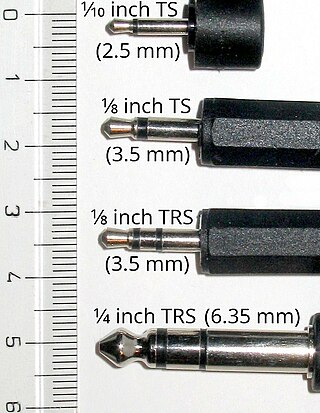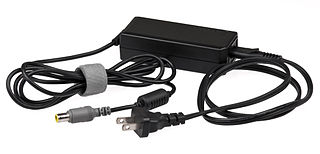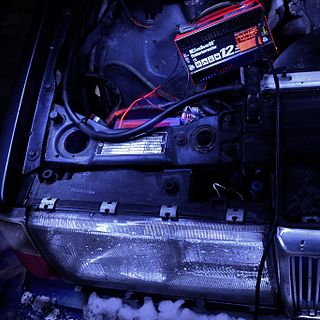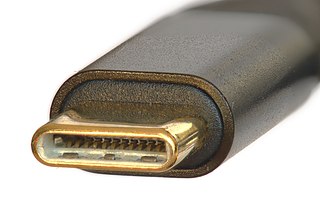
Universal Serial Bus (USB) is an industry standard that allows data exchange and delivery of power between many types of electronics. It specifies its architecture, in particular its physical interface, and communication protocols for data transfer and power delivery to and from hosts, such as personal computers, to and from peripheral devices, e.g. displays, keyboards, and mass storage devices, and to and from intermediate hubs, which multiply the number of a host's ports.

A phone connector is a family of cylindrically-shaped electrical connectors primarily for analog audio signals. Invented in the late 19th century for telephone switchboards, the phone connector remains in use for interfacing wired audio equipment, such as headphones, speakers, microphones, mixing consoles, and electronic musical instruments. A male connector, is mated into a female connector, though other terminology is used.

A DC connector is an electrical connector for supplying direct current (DC) power.

An AC adapter or AC/DC adapter is a type of external power supply, often enclosed in a case similar to an AC plug. AC adapters deliver electric power to devices that lack internal components to draw voltage and power from mains power themselves. The internal circuitry of an external power supply is often very similar to the design that would be used for a built-in or internal supply.

The history of mobile phones covers mobile communication devices that connect wirelessly to the public switched telephone network.

A battery charger, recharger, or simply charger, is a device that stores energy in a battery by running an electric current through it. The charging protocol depends on the size and type of the battery being charged. Some battery types have high tolerance for overcharging and can be recharged by connection to a constant voltage source or a constant current source, depending on battery type.

MagSafe is a series of proprietary magnetically attached power connectors developed by Apple Inc. for Mac laptops. MagSafe was introduced on 10 January 2006, in conjunction with the MacBook Pro, the first Intel-based Mac laptop, at the Macworld Expo. A MagSafe connector is held in place magnetically so that if it is tugged, it will be pulled out of the port without damaging the connector or the port, and without pulling the computer off its surface. A thinner and wider version, called MagSafe 2, was introduced in 2012. It was discontinued across Apple's product lines between 2016 and 2019 and replaced with USB-C. MagSafe returned to Mac laptops with the introduction of updated MacBook Pro models with MagSafe 3 in 2021.
Oppo is a Chinese consumer electronics manufacturer headquartered in Dongguan, Guangdong. Its major product lines include smartphones, smart devices, audio devices, power banks, and other electronic products.

A dock connector is an electrical connector used to attach a mobile device simultaneously to multiple external resources. The dock connector will typically carry a variety of signals and power, through a single connector, to simplify the process of docking the device. A dock connector may be embedded in a mechanical fixture used to support or align the mobile device or may be at the end of a cable.

Universal charger or common charger refers to various projects to standardize the connectors of power supplies, particularly for battery-powered devices.

The common external power supply was a European Commission (EC) specification for a universal charger for smartphones sold within the European Union. The specification included the use of a USB Micro-B connector and adherence to the USB Battery Charging Specification.

Lightning is a proprietary computer bus and power connector, created and designed by Apple Inc. It was introduced on September 12, 2012, in conjunction with the iPhone 5, to replace its predecessor, the 30-pin dock connector. The Lightning connector is used to connect Apple mobile devices like iPhones, iPads, and iPods to host computers, external monitors, cameras, USB battery chargers, and other peripherals. Using 8 pins instead of 30, Lightning is much smaller than its predecessor. The Lightning connector is reversible. The plug is indented on each side to match up with corresponding points inside the receptacle to retain the connection.

Conductive charging is conductive power transfer that replaces the conductive wires between the charger and the charged device with conductive contacts. Charging infrastructure in the form of a board or rail delivers the power to a charging device equipped with an appropriate receiver, or pickup. When the infrastructure recognizes a valid receiver it powers on, and power is transferred.

USB-C, or USB Type-C, is a 24-pin connector that supersedes previous USB connectors and can carry audio, video and other data, e.g., to drive multiple displays or to store a backup to an external drive. It can also provide and receive power, such as powering a laptop or a mobile phone. It is applied not only by USB technology, but also by other protocols, including Thunderbolt, PCIe, HDMI, DisplayPort, and others. It is extensible to support future standards.

Quick Charge (QC) is a proprietary battery charging protocol developed by Qualcomm, used for managing power delivered over USB, mainly by communicating to the power supply and negotiating a voltage.
The Radio Equipment Directive established a regulatory framework for placing radio equipment on the market in the EU. All radio equipment within the scope of this directive that are placed on the EU market must have been compliant with the directive from 13 June 2017. The delay of the publication and approval of the details of this directive has led to difficulties for companies attempting to comply with the directive.
The initial versions of the USB standard specified connectors that were easy to use and that would have acceptable life spans; revisions of the standard added smaller connectors useful for compact portable devices. Higher-speed development of the USB standard gave rise to another family of connectors to permit additional data paths. All versions of USB specify cable properties; version 3.x cables include additional data paths. The USB standard included power supply to peripheral devices; modern versions of the standard extend the power delivery limits for battery charging and devices requiring up to 240 watts. USB has been selected as the standard charging format for many mobile phones, reducing the proliferation of proprietary chargers.

MagSafe is a proprietary, magnetically attached wireless power transfer and accessory-attachment standard developed by Apple Inc. for its iPhone and AirPods product lines. It was announced on 13 October 2020, in conjunction with the iPhone 12 and 12 Pro series. It provides up to 15 W of power and is compatible with the open Qi standard for up to 7.5 W of power. The connector also enables connecting non-charger accessories such as card holders and cases with communication through an integrated NFC loop. The charger uses a circle of rare-earth magnets.

The iPhone 15 Pro and iPhone 15 Pro Max are smartphones designed, developed, and marketed by Apple Inc. They are the seventeenth-generation flagship iPhones, succeeding the iPhone 14 Pro and iPhone 14 Pro Max.

The iPhone 15 and iPhone 15 Plus are smartphones designed, developed, and marketed by Apple Inc. They are the seventeenth and current generation of iPhones, succeeding the iPhone 14 and iPhone 14 Plus. The devices were announced on September 12, 2023, during the Apple Event at Apple Park in Cupertino, California alongside the higher-priced iPhone 15 Pro and 15 Pro Max. Pre-orders began on September 15, 2023, and the devices were made available on September 22, 2023. Like the iPhone 15 Pro and Pro Max, the 15 and 15 Plus are the first iPhones to replace the proprietary Lightning connector with USB-C to comply with European Union mandates.

















